SEO
How to optimize keywords and SEO titles with popular keywords

30-second summary:
- Title optimization of articles, blogs, or webpages is critical to get traffic and earn money from Adsense and affiliates
- The standard advice is to stick to one keyword phrase per page to maintain strict relevance and avoid getting penalized for keyword stuffing
- Adding extra related keywords, however, apart from the modifiers and words to create a sensible title has the potential to get more traffic to websites
- Here are some good insights and tips on how you can optimize your keywords titles
Optimizing titles of articles, blogs or webpages is critical for getting traffic and earning money from Adsense and affiliates. The standard advice is to stick to one keyword phrase per page to maintain strict relevance and avoid getting penalized for keyword stuffing. But adding extra, related keywords, apart from the modifiers and words to create a sensible title, has the potential to get more traffic to your site.
In this article, I’ll review, my own experience in crafting carefully multiple keyword titles.
Keep the title short – one keyword phrase to a page
As a golden tip, start targeting individual keywords on separate pages and use multiple pages for related words. General landing pages for mixed or general topics generally will not work because you will not be able to compete for popular single keywords without adding phrases for longtail titles. The general advice is that you should keep the title short (less than 70 characters) and only target perhaps two or three primary keywords that are highly relevant to the content of the page and its objective. You can of course develop long-tail keywords that include your primary keywords plus a series of modifiers to make a ‘sensible’ title that makes sense to humans and the test the bots use to evaluate your sites.
Avoid keyword stuffing
There is a lot of information on the dangers of keyword stuffing, which means over-use of your keyword or keywords in the title, description, and the body copy. Google invokes a penalty for keyword stuffing, though the threshold keyword density is not exactly known. There are various tools for counting keyword use frequencies. Keyword Density is simply measured as the relative number of times your search term (Keyword or Keyword phrase) occurs as a percentage of the total number of words on a given page. The ideal Keyword Density must not be greater than 5.5 percent. But various search engines have different thresholds before they apply penalties. Reasonably, high Keyword Densities can help boost page rankings but you don’t have to overdo it.
Keyword Density can be boosted by using your keywords repeatedly in the:
- Title tag
- Header tag
- Comment tag
- Body tag
- Anchor tag
- Image tag
- Alt tag
- Domain name, and
- Paragraph tag
Another general piece of advice for titles is not to exceed using the identical keyword in the title more than twice.
How Google and other search engines crawl and rank your keywords in the title
It is not widely understood, but Google and other search engines register and rank every individual keyword in your title and every combination – including various orders and positions for the keywords. Although there is a priority for phrases with the keywords in the order they are in the Title, and for words that appear first, Google will register all the keywords and phrases and derive a ranking for them.
Dilution of the weight of the keywords in the title
Google also appears to regard long titles as more likely to be Spammy (especially very long titles). Longer titles may also appear keyword-stuffed. Research has shown that the first keyword in the title has the highest weight; the second keyword has somewhat less weight and so on. By adding more words you may dilute the weight applied to each of them. For targeting two-word searches and phrases, it is important to keep keywords close to each other and in their ‘natural’ order. Try to match the likely order of the terms in the search phrase, to the order in the title.
Use multiple keyword phrases multiply your traffic
If Google derives a rank for all the words in the title, surely, by including two or three keywords rather than one will be more likely to get more traffic. The traffic for each word should add up and multiply. Understanding when this is appropriate and when it is not is the crux of optimizing titles. As explained previously the weight or value of the keyword appears to fall rapidly as you move from the first word to the last. More keywords appear to dilute the weight given for each word. Also, there is the important issue of relevance. Your page may be penalized if the words you use are not highly relevant to the content of the page.
The key aspect is competition – only use a single phrase if the competition is high
If there is a lot of competition for a keyword then it is best to only use a single keyword or phrase. Stick to the keyword phrase you have found using the Google Keyword Planner for use in the title. You know the statistic and competition for that exact phrase and it is unwise to fiddle with it. Various tools can be used to estimate competition for the phrase and the likely traffic. The Keyword Research tool shows how even minor changes in the phrase can dramatically affect traffic and competition.
If the competition is high you have to maintain the strength of your page and title to compete. Adding extra phrases will dilute the weight applied to the keyword. You will be competing against pages that are likely to be strongly targeted on that keyword phrase as well. You could lose the battle if you don’t have that singular, highly focused title for the keyword.
If there is moderate competition enrich your title with more keywords
For moderate competition, there are several ways you can go to use multiple keywords in the title.
1. Use two or more Modifiers
The solution to not duplicating the keyword is to add one or two extra modifiers or action words. If you look at the competitive keyword phrases shown by the Google Keyword Tool you will often find that two phrases look promising that both contain the primary keyword or phrase. [action word 1 keyword] + [keyword action word 2] = [action word 1 keyword action word 2]
Let’s say, for instance, you are after a keyword title for your article about Green Tea health benefits and you want to use a longtail keyword narrowing the search to extracts. The obvious solution is:
- Health Benefits of Green Tea Extracts
This provides a title for four phrases
- Benefits of Green
- Health Benefits of Green Tea
- Green Tea Extracts
- Health Benefits of Green Tea Extracts
Another example is a title about Professional Make-up Artists
Reviews of Professional Make-up Artists + Make-up Artist Portfolios = Reviews of Professional Make-up Artist Portfolios
This makes the title target four phrases in one:
- Reviews of Professional Make-up Artists
- Make-up Artist Portfolios
- Professional make-up artist portfolios
- Reviews of Professional Make-up Artist Portfolios
In both cases, this very simple tactic makes it possible to create a short concise title that is enriched by optimizing it for more than one key term and narrowing down your target audience. Perhaps your article is about creating portfolios and how to find and review make-up artists and this title targets these keywords. Of course, it is often hard to find word combinations similar to these and it emphasizes that title design is a real art. These examples also show how the use of action keywords and modifier phrases to target buyers who are ready to buy, which will fulfill the aim of your website.
2. Long tail action based keyword choices
Long-tail titles using action words are generally more effective, as action-based queries usually attract users that have already got their credit card out and are hungry to find what they want and to buy it. Targeting your audience will lose part of the potential audience but the ones you have filtered for will be more likely to buy.
The role of SEO title optimization is to enrich the keywords in the title that potential buyers might use when conducting a search to target the group that is interested in your product or services.
The best strategy is to build the longtail keyword title, not by using poorly selected action words as modifiers, but by researching the action words and phrases as well for maximum benefit.
Combine competitive keyword phrases to enrich the title
The Google Keyword Planner Tool might show two promising keyword phrases essentially related to the same topic. Let say, for instance, that you are trying to market green tea extracts using their health benefits, particularly to help people having issues with losing weight. The Google Keyword Planner Tool shows three competitive phrases
- green tea health benefits
- green tea extract
- green tea health benefits for weight loss
These phrases can be combined in ways that retain the order of the words (with green tea as the first phrase) but allow all these phrases to work in your title.
For example
- Green Tea Extract: Health Benefits for Weight Loss
This longtail keyword is optimized for all three competitive phrases.
The ideal separator for two phrases
What is the ideal separator when using multiple keyword phrases? It does not really matter. You can use a pipe (|), a colon (:) a dash (-), or a comma (,)
However, don’t use the underscore ( _ ) as search engines don’t recognize it as a separator. These characters have no ranking benefit, but they help make your title readable.
Dealing with plurals and synonyms
In some cases, you may want to expand the keywords in the title to include plurals, synonyms, and other expressions for your topic. For example “architect supply”, “architectural supplies” and “technical drawing equipment” essentially deal with the same topic. You will need to craft the title to include these variants if you can.
For example: “Architectural supplies: Technical Drawing Equipment for Architects”
One of the potential dangers with targeting a single term in your title is that it creates a tendency for over-optimization, even when it’s not intended. You may use that single keyword everywhere on your page. If you include variants this is less likely to happen.
Don’t overdo it!
You need to be careful because adding more keywords can mean that each of them will have less and less impact. The more you try to stuff extra keywords into the less natural it is going to sound. For example, if you use the following title it will appear in the search results as –
Cheap Coffee | Gourmet Coffee | Ground Gourmet Coffee
Google won’t like it as it will be interpreted as keyword stuffing. Your potential customers won’t like it because they will see it as unnatural and likely to provide useless promotional material
Much better would be:
Low Price Ground Gourmet Coffee and Fresh Roasted Bean Suppliers
Which version looks better in the search results? Which one is less likely to be seen as keyword stuffing and deception?
If you have a keyword ‘Recycling Information – How And Where To Recycle
What if you want to optimize an article for the keyword “Recycling Tips” as well?
You could build a title such as
Recycling Information – Recycling Tips – How and Why Recycling is Better
But this is clearly keyword stuffing and Google will probably penalize it.
A better option is
Recycling Information – Tips, Tricks and How to Recycle
You can see that your second keyword recycling tips is in the title, but with the keyword word information in between. This will be slightly less effective but Google will still list you page for the keyword Recycling Information – Tips. If you look at the search results where the matching keywords are shown in ‘bold’, you will notice that this often occurs even for pages that appear high up in the search results.
Final thoughts
- Building traffic is important, but it is conversion rates that really matter
- The keyword “tail” should not “wag” your dog (marketing strategy). Keep the focus on the major keyword and keep it at the front of your title.
- Use association and keyword matching to group keywords. Rank your potential phrases for search popularity, but make sure you can compete for them and cascade down by adding modifiers to build a longtail title that will work.
- Never forget that a human user will determine your conversion rates, not the search engines
- Your titles must be readable and appealing
If you do all this along with writing high-quality content intended for people and optimized for Google, your articles, blog, or webpages will suddenly be ranking for multiple keywords with high conversion rates. You may even end up being in the first spot for a keyword that was never your main focus.
Jacob M. is a copywriter, marketing blogger, inbound marketing consultant, and founder of Write Minds. He can be found on Twitter @jmcmillen89.
Subscribe to the Search Engine Watch newsletter for insights on SEO, the search landscape, search marketing, digital marketing, leadership, podcasts, and more.
Source: Jacob M.
SEO
Measuring Content Impact Across The Customer Journey
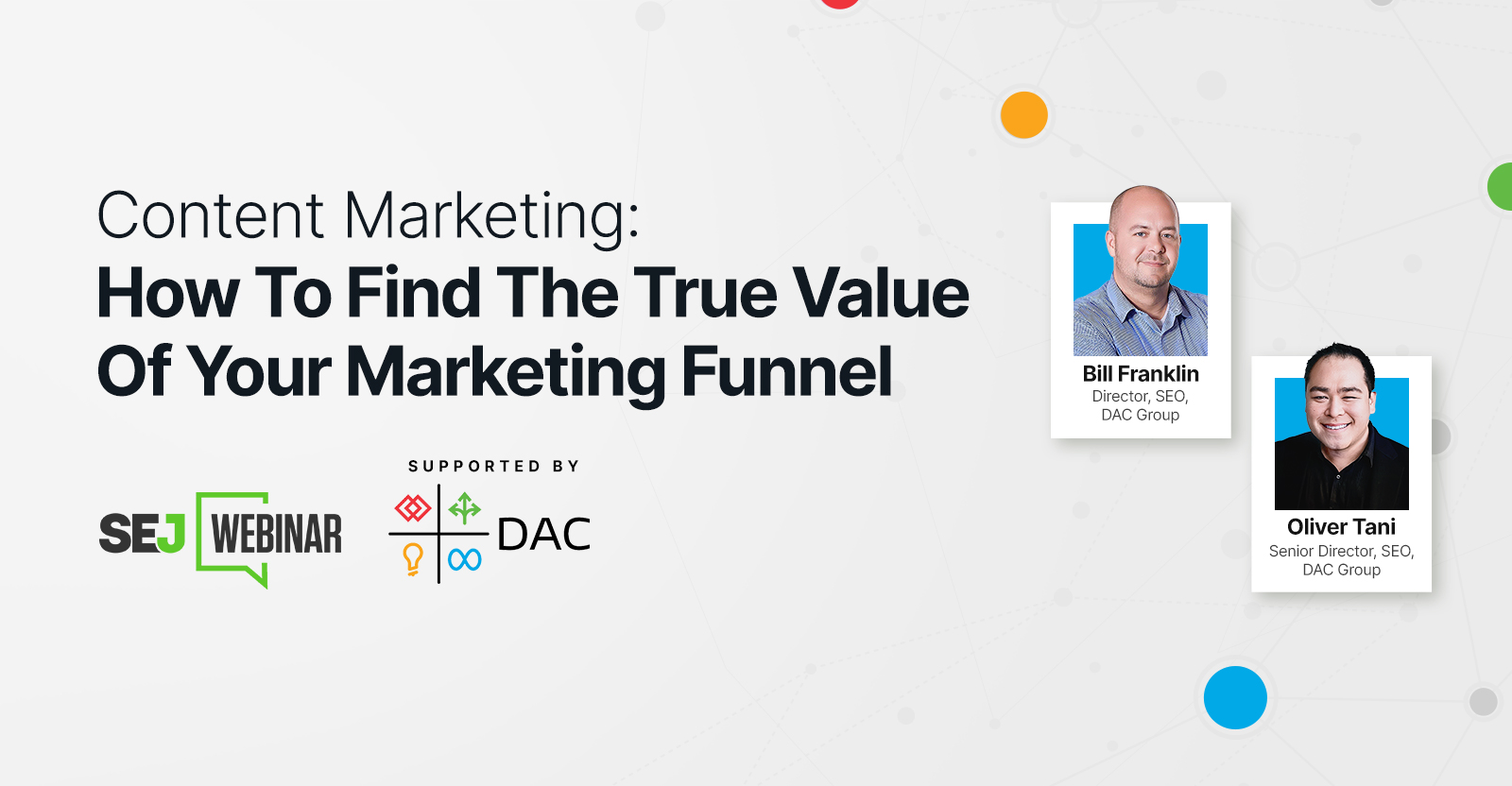
Understanding the impact of your content at every touchpoint of the customer journey is essential – but that’s easier said than done. From attracting potential leads to nurturing them into loyal customers, there are many touchpoints to look into.
So how do you identify and take advantage of these opportunities for growth?
Watch this on-demand webinar and learn a comprehensive approach for measuring the value of your content initiatives, so you can optimize resource allocation for maximum impact.
You’ll learn:
- Fresh methods for measuring your content’s impact.
- Fascinating insights using first-touch attribution, and how it differs from the usual last-touch perspective.
- Ways to persuade decision-makers to invest in more content by showcasing its value convincingly.
With Bill Franklin and Oliver Tani of DAC Group, we unravel the nuances of attribution modeling, emphasizing the significance of layering first-touch and last-touch attribution within your measurement strategy.
Check out these insights to help you craft compelling content tailored to each stage, using an approach rooted in first-hand experience to ensure your content resonates.
Whether you’re a seasoned marketer or new to content measurement, this webinar promises valuable insights and actionable tactics to elevate your SEO game and optimize your content initiatives for success.
View the slides below or check out the full webinar for all the details.
SEO
How to Find and Use Competitor Keywords
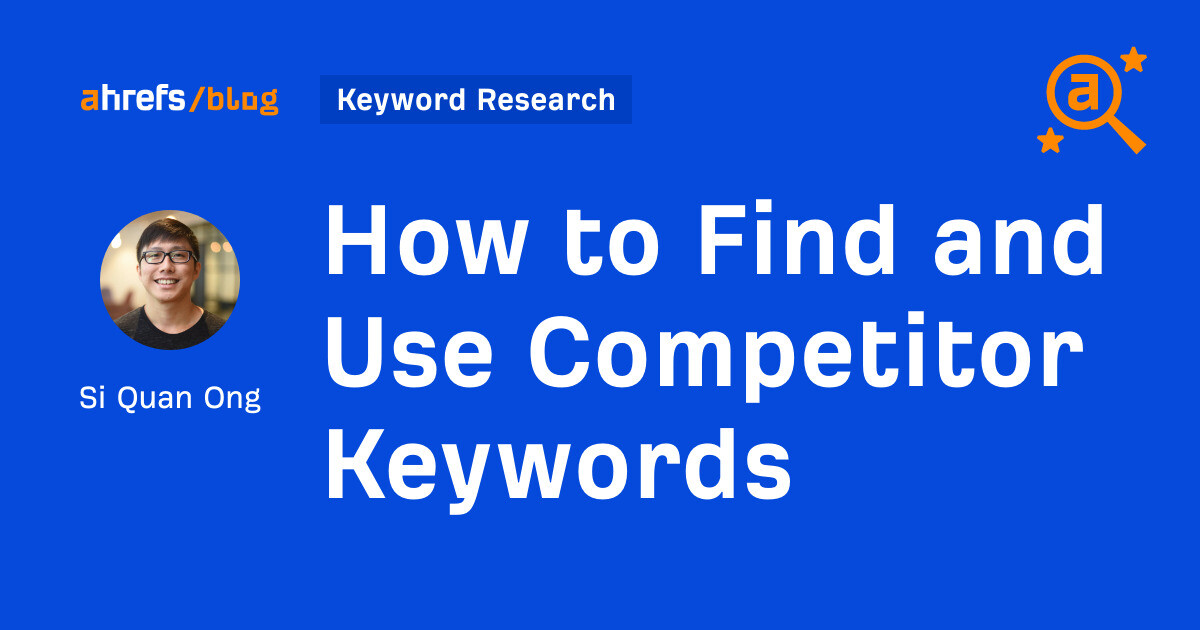
Competitor keywords are the keywords your rivals rank for in Google’s search results. They may rank organically or pay for Google Ads to rank in the paid results.
Knowing your competitors’ keywords is the easiest form of keyword research. If your competitors rank for or target particular keywords, it might be worth it for you to target them, too.
There is no way to see your competitors’ keywords without a tool like Ahrefs, which has a database of keywords and the sites that rank for them. As far as we know, Ahrefs has the biggest database of these keywords.
How to find all the keywords your competitor ranks for
- Go to Ahrefs’ Site Explorer
- Enter your competitor’s domain
- Go to the Organic keywords report
The report is sorted by traffic to show you the keywords sending your competitor the most visits. For example, Mailchimp gets most of its organic traffic from the keyword “mailchimp.”


Since you’re unlikely to rank for your competitor’s brand, you might want to exclude branded keywords from the report. You can do this by adding a Keyword > Doesn’t contain filter. In this example, we’ll filter out keywords containing “mailchimp” or any potential misspellings:
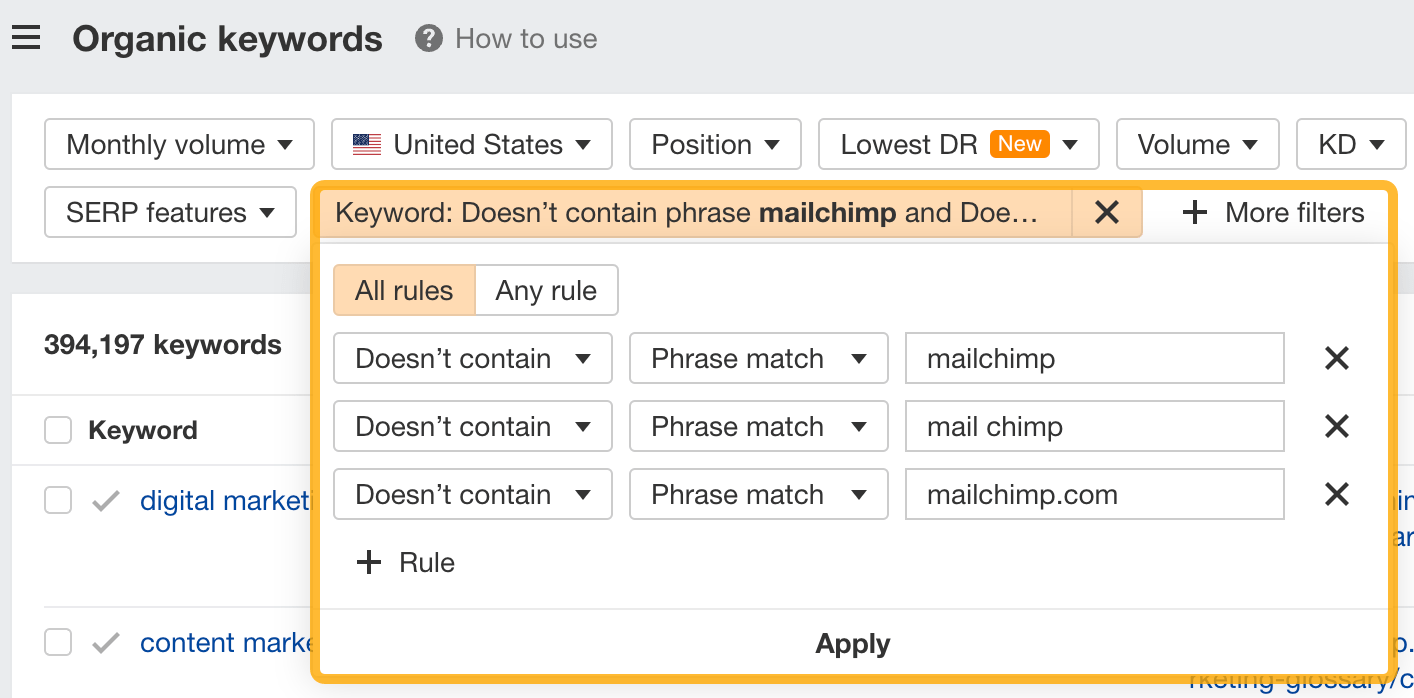

If you’re a new brand competing with one that’s established, you might also want to look for popular low-difficulty keywords. You can do this by setting the Volume filter to a minimum of 500 and the KD filter to a maximum of 10.
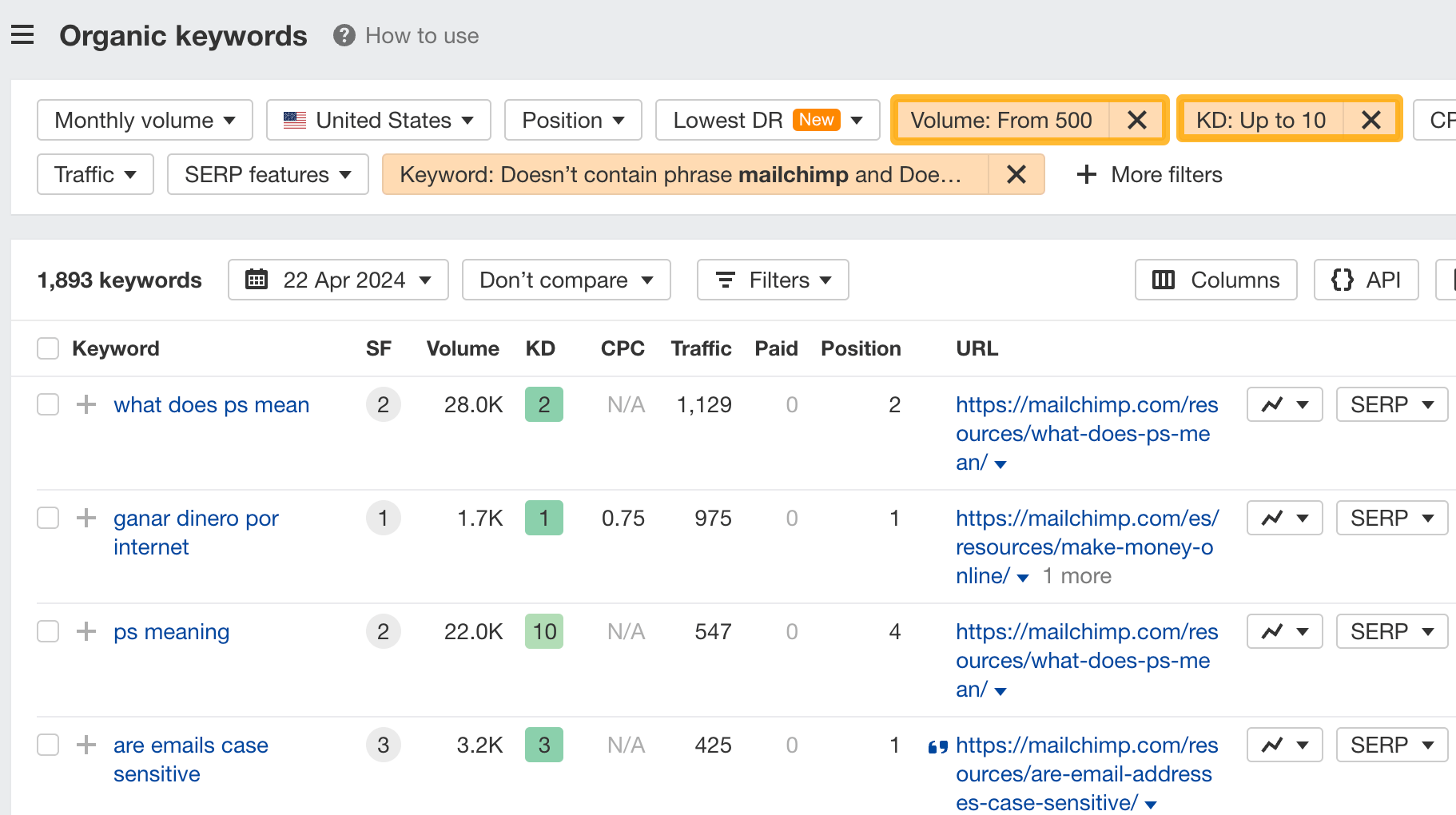

How to find keywords your competitor ranks for, but you don’t
- Go to Competitive Analysis
- Enter your domain in the This target doesn’t rank for section
- Enter your competitor’s domain in the But these competitors do section
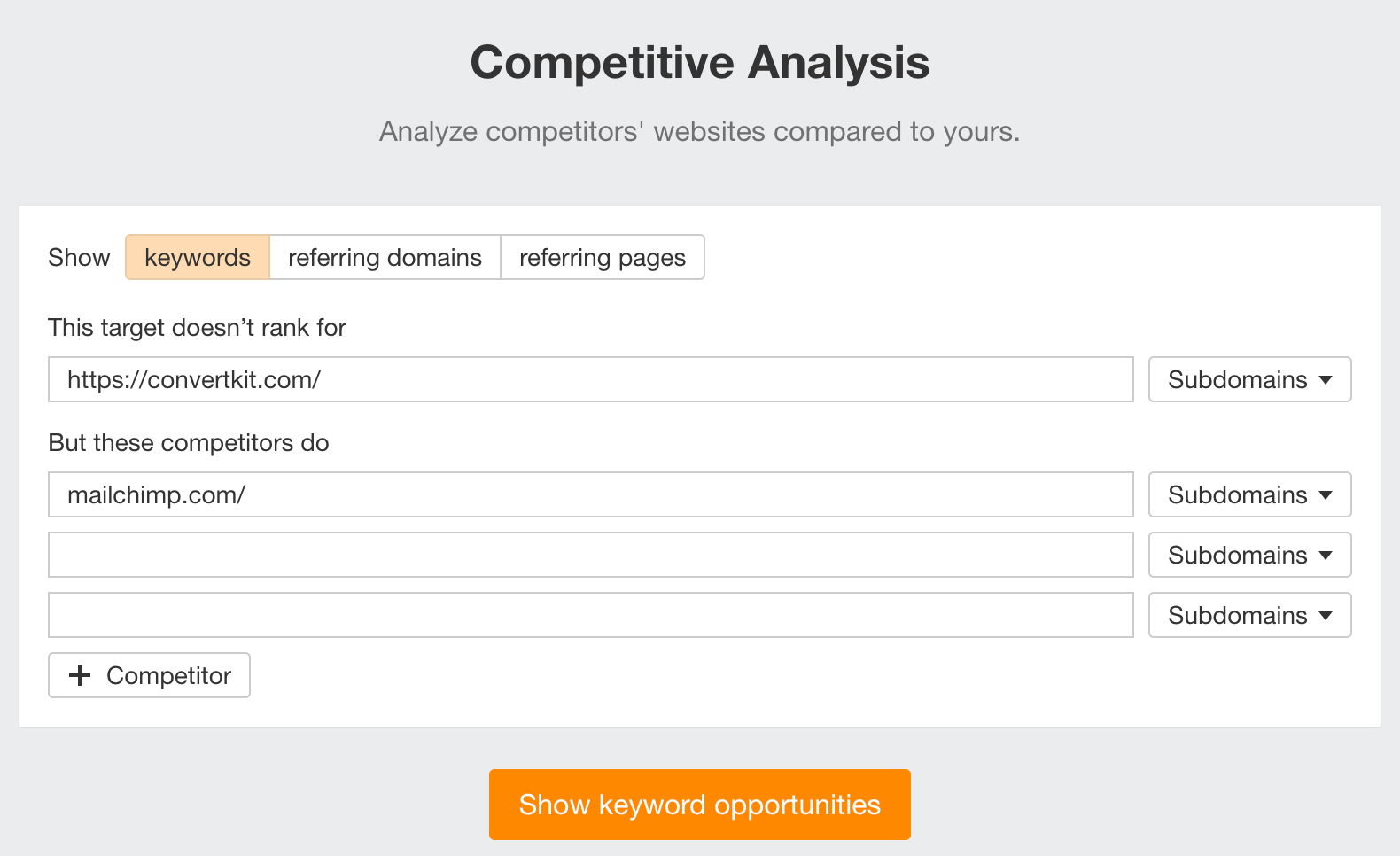

Hit “Show keyword opportunities,” and you’ll see all the keywords your competitor ranks for, but you don’t.
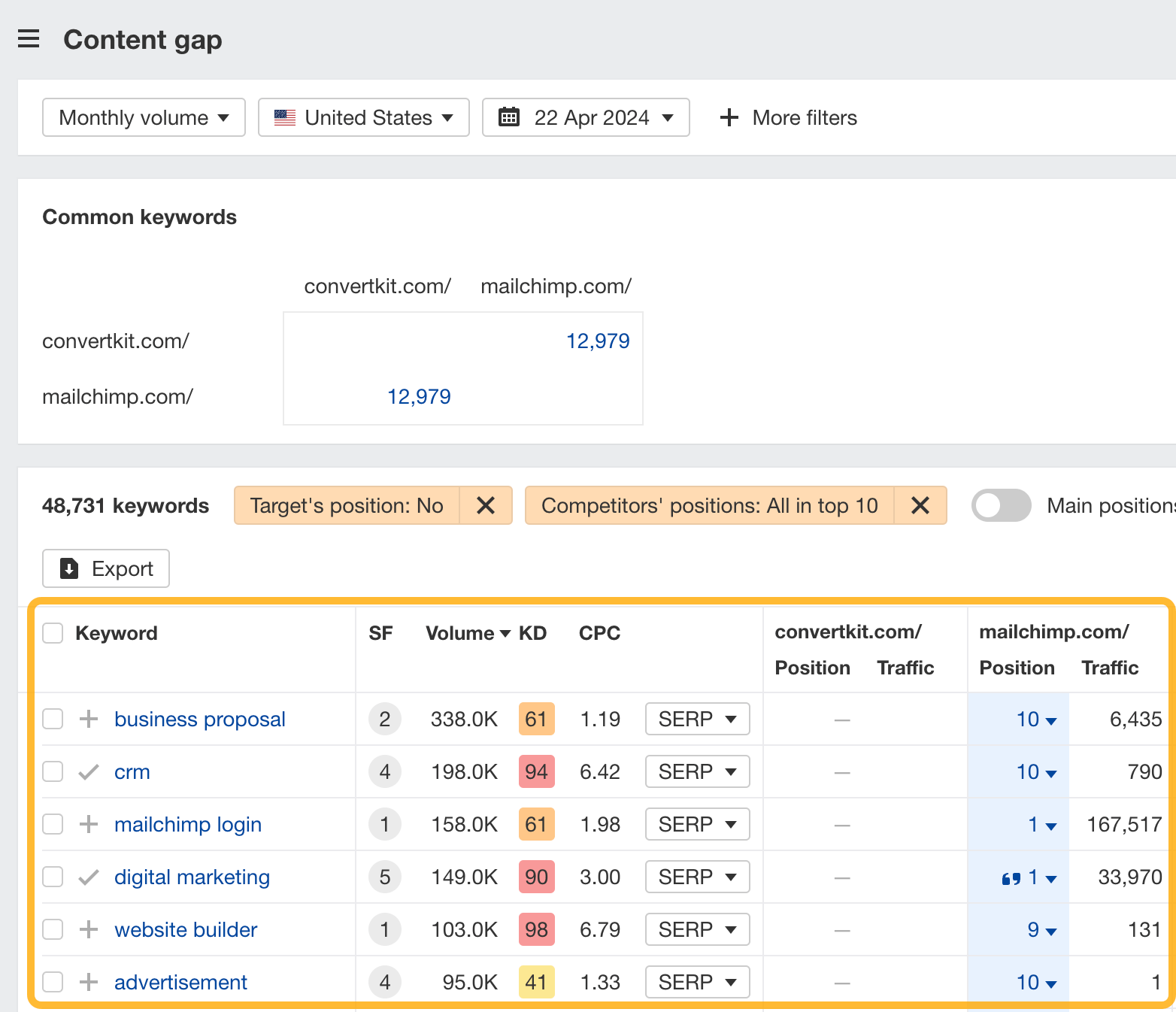

You can also add a Volume and KD filter to find popular, low-difficulty keywords in this report.
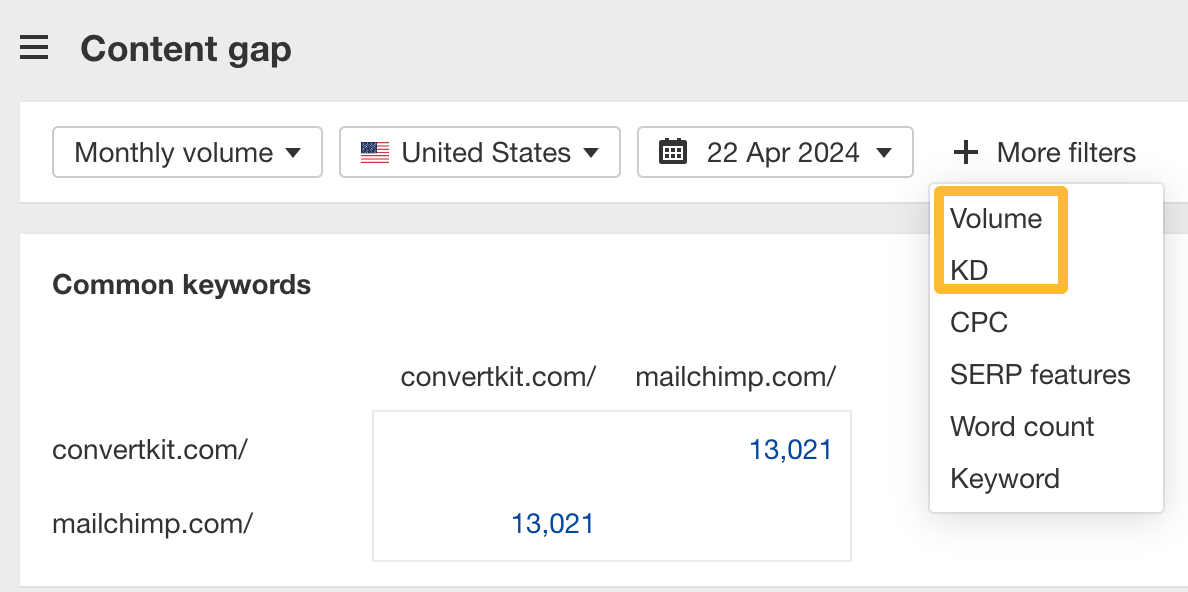

How to find keywords multiple competitors rank for, but you don’t
- Go to Competitive Analysis
- Enter your domain in the This target doesn’t rank for section
- Enter the domains of multiple competitors in the But these competitors do section
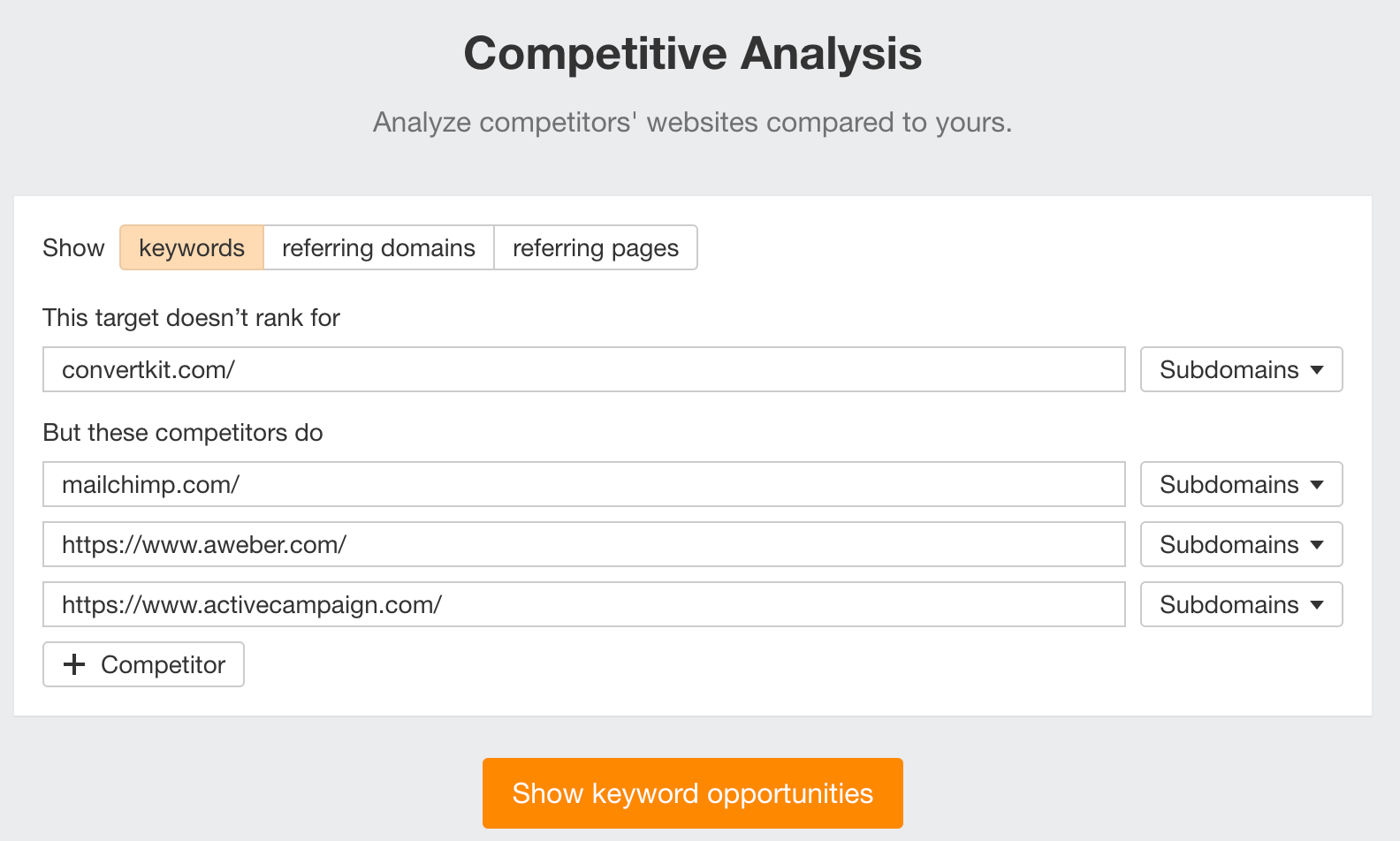

You’ll see all the keywords that at least one of these competitors ranks for, but you don’t.
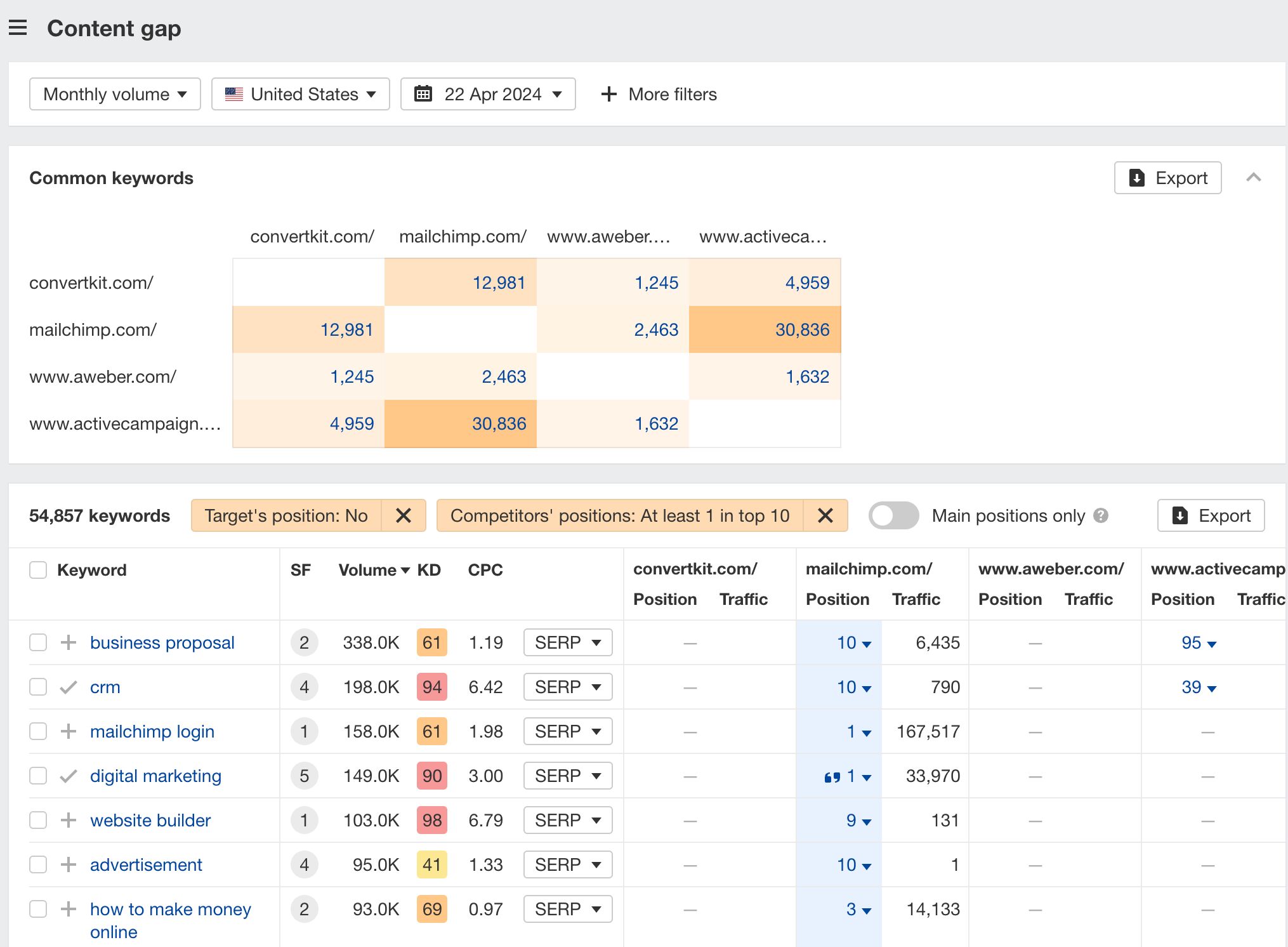

You can also narrow the list down to keywords that all competitors rank for. Click on the Competitors’ positions filter and choose All 3 competitors:
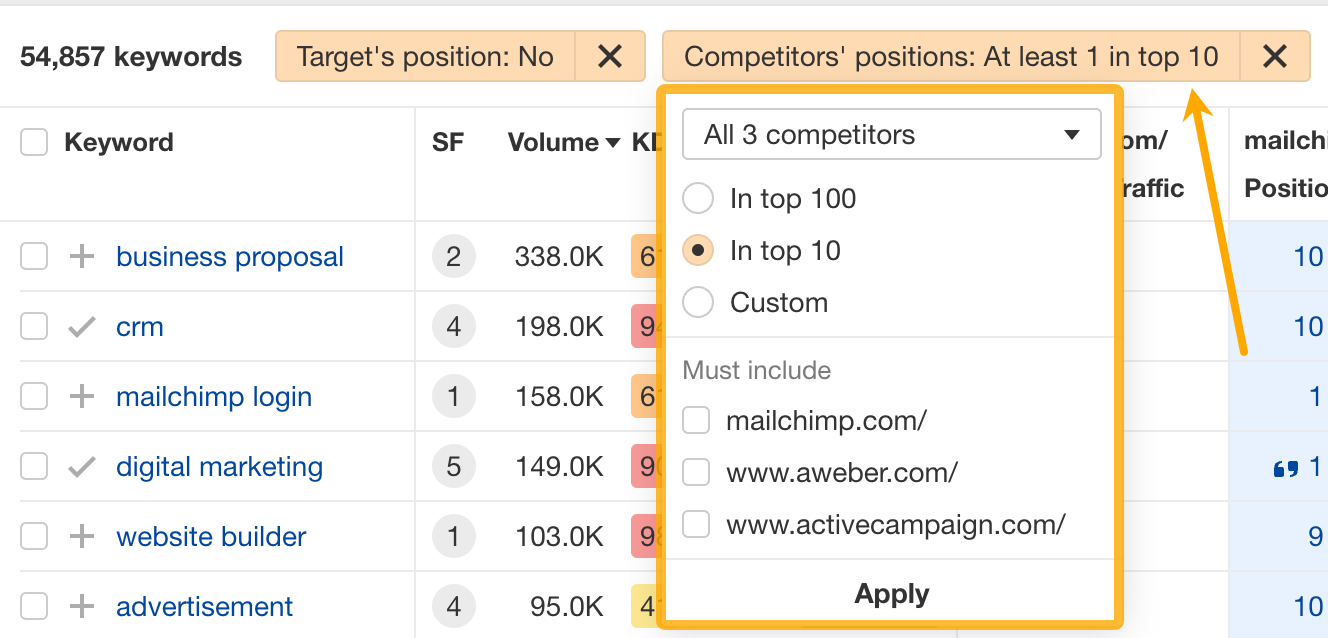

- Go to Ahrefs’ Site Explorer
- Enter your competitor’s domain
- Go to the Paid keywords report
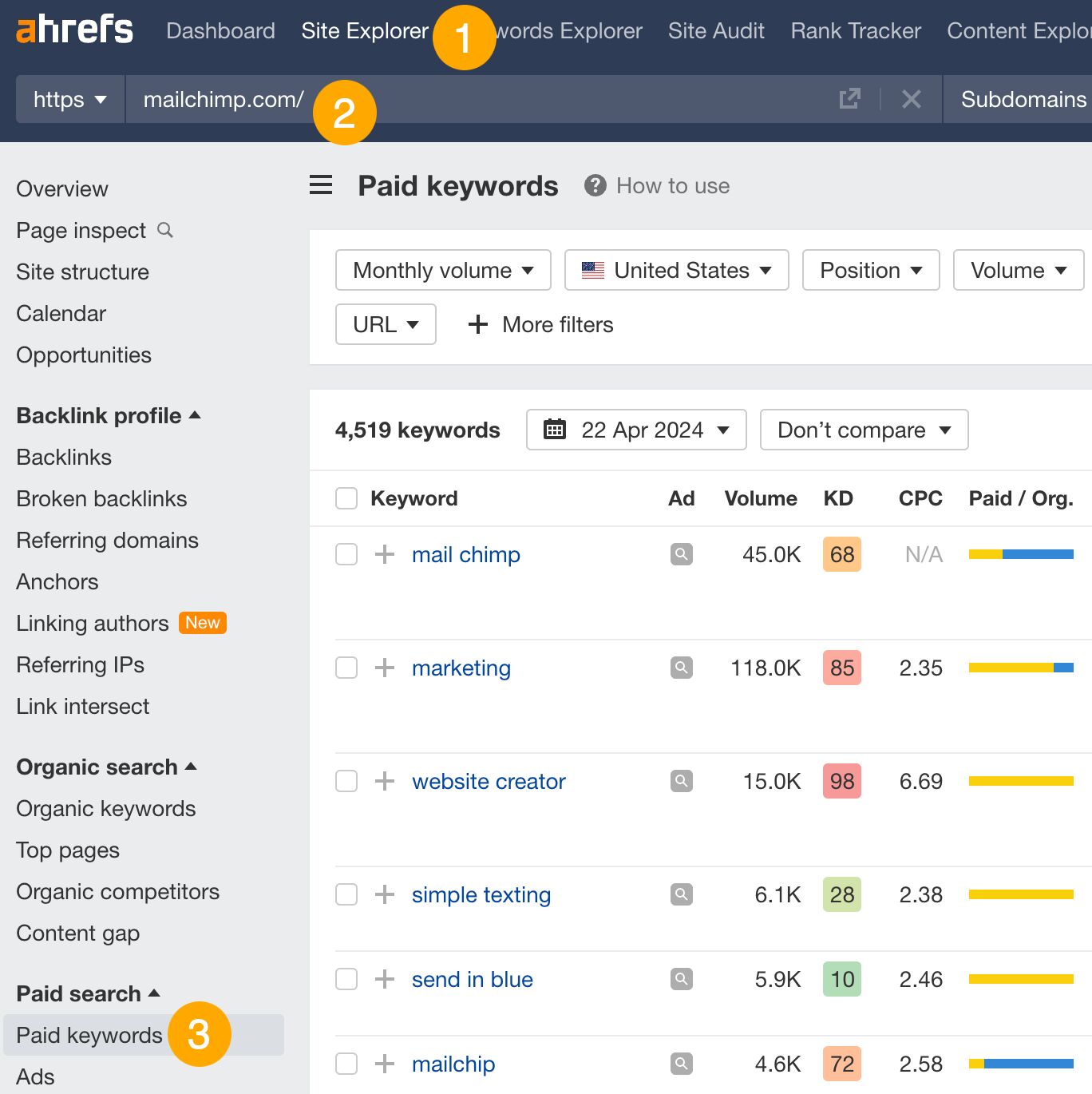

This report shows you the keywords your competitors are targeting via Google Ads.
Since your competitor is paying for traffic from these keywords, it may indicate that they’re profitable for them—and could be for you, too.
You know what keywords your competitors are ranking for or bidding on. But what do you do with them? There are basically three options.
1. Create pages to target these keywords
You can only rank for keywords if you have content about them. So, the most straightforward thing you can do for competitors’ keywords you want to rank for is to create pages to target them.
However, before you do this, it’s worth clustering your competitor’s keywords by Parent Topic. This will group keywords that mean the same or similar things so you can target them all with one page.
Here’s how to do that:
- Export your competitor’s keywords, either from the Organic Keywords or Content Gap report
- Paste them into Keywords Explorer
- Click the “Clusters by Parent Topic” tab
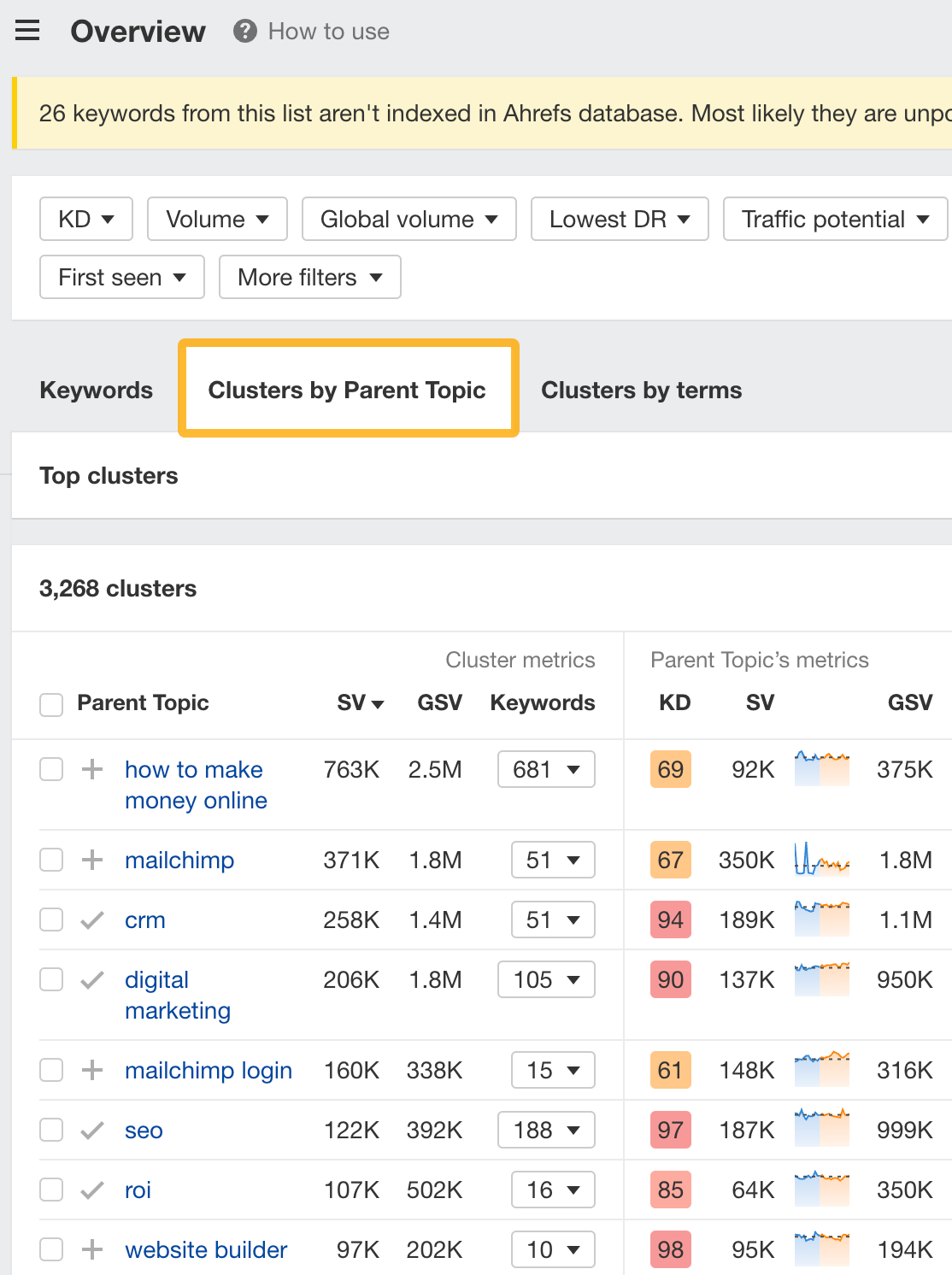

For example, MailChimp ranks for keywords like “what is digital marketing” and “digital marketing definition.” These and many others get clustered under the Parent Topic of “digital marketing” because people searching for them are all looking for the same thing: a definition of digital marketing. You only need to create one page to potentially rank for all these keywords.
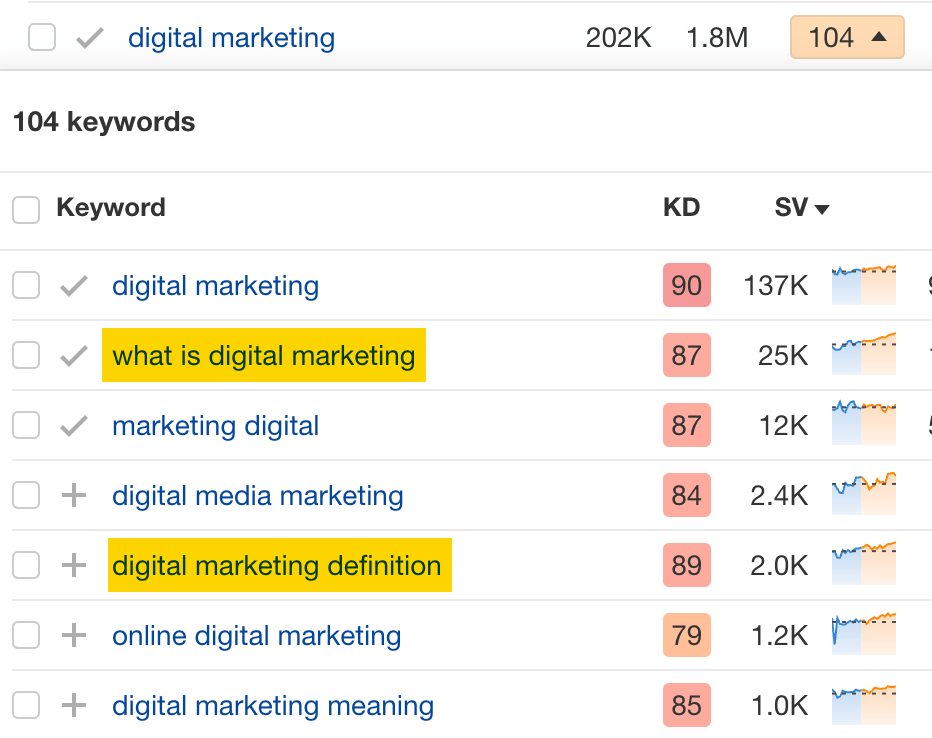

2. Optimize existing content by filling subtopics
You don’t always need to create new content to rank for competitors’ keywords. Sometimes, you can optimize the content you already have to rank for them.
How do you know which keywords you can do this for? Try this:
- Export your competitor’s keywords
- Paste them into Keywords Explorer
- Click the “Clusters by Parent Topic” tab
- Look for Parent Topics you already have content about
For example, if we analyze our competitor, we can see that seven keywords they rank for fall under the Parent Topic of “press release template.”


If we search our site, we see that we already have a page about this topic.


If we click the caret and check the keywords in the cluster, we see keywords like “press release example” and “press release format.”
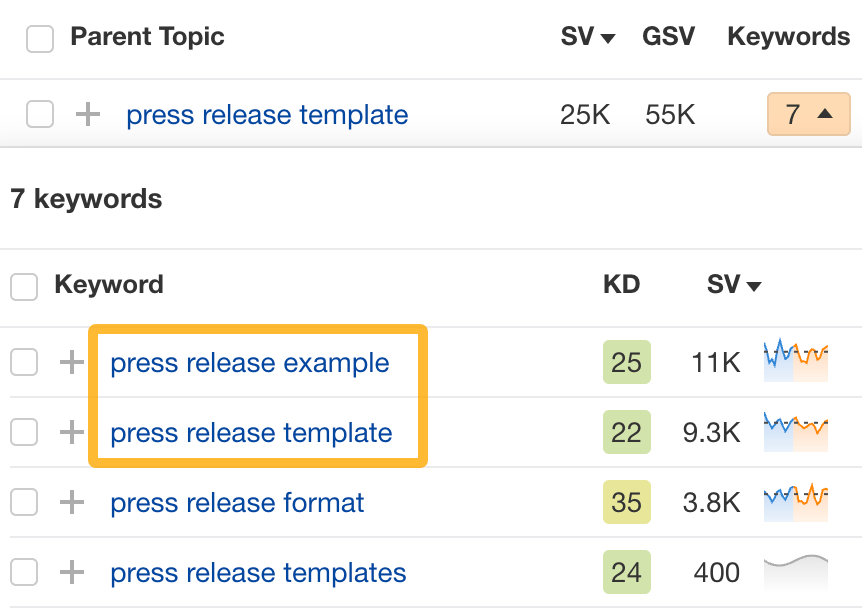

To rank for the keywords in the cluster, we can probably optimize the page we already have by adding sections about the subtopics of “press release examples” and “press release format.”
3. Target these keywords with Google Ads
Paid keywords are the simplest—look through the report and see if there are any relevant keywords you might want to target, too.
For example, Mailchimp is bidding for the keyword “how to create a newsletter.”


If you’re ConvertKit, you may also want to target this keyword since it’s relevant.
If you decide to target the same keyword via Google Ads, you can hover over the magnifying glass to see the ads your competitor is using.
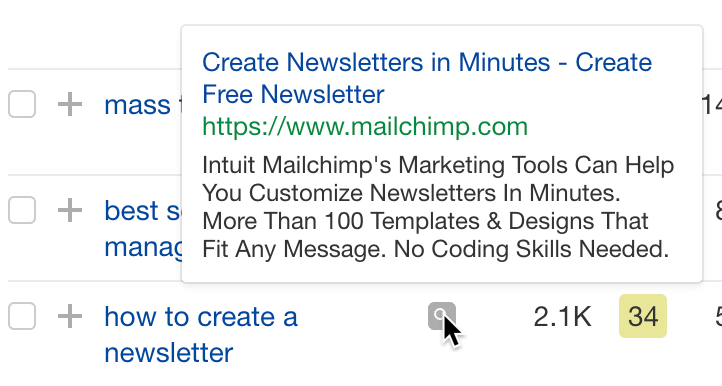

You can also see the landing page your competitor directs ad traffic to under the URL column.


Learn more
Check out more tutorials on how to do competitor keyword analysis:
SEO
Google Confirms Links Are Not That Important
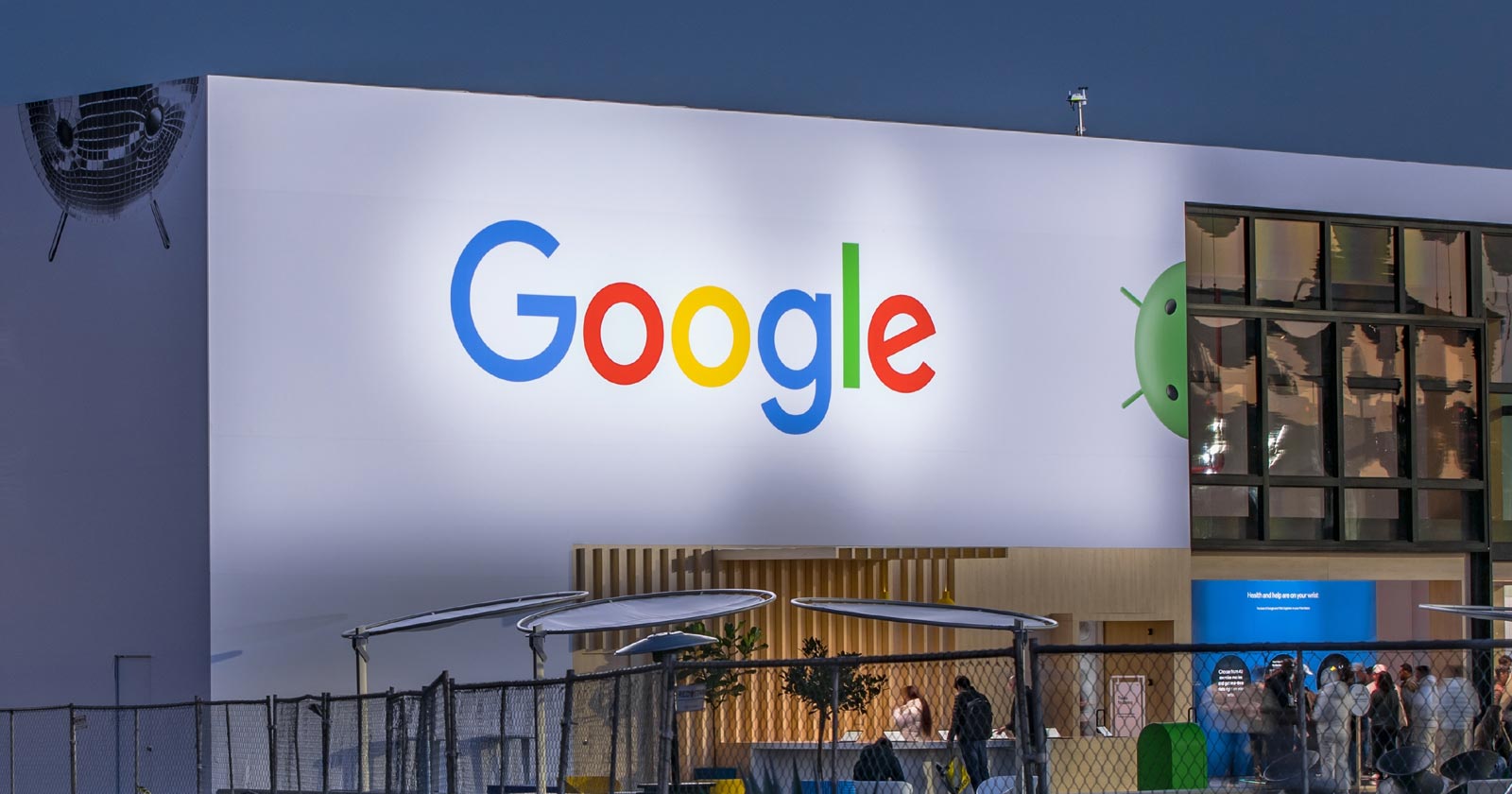
Google’s Gary Illyes confirmed at a recent search marketing conference that Google needs very few links, adding to the growing body of evidence that publishers need to focus on other factors. Gary tweeted confirmation that he indeed say those words.
Background Of Links For Ranking
Links were discovered in the late 1990’s to be a good signal for search engines to use for validating how authoritative a website is and then Google discovered soon after that anchor text could be used to provide semantic signals about what a webpage was about.
One of the most important research papers was Authoritative Sources in a Hyperlinked Environment by Jon M. Kleinberg, published around 1998 (link to research paper at the end of the article). The main discovery of this research paper is that there is too many web pages and there was no objective way to filter search results for quality in order to rank web pages for a subjective idea of relevance.
The author of the research paper discovered that links could be used as an objective filter for authoritativeness.
Kleinberg wrote:
“To provide effective search methods under these conditions, one needs a way to filter, from among a huge collection of relevant pages, a small set of the most “authoritative” or ‘definitive’ ones.”
This is the most influential research paper on links because it kick-started more research on ways to use links beyond as an authority metric but as a subjective metric for relevance.
Objective is something factual. Subjective is something that’s closer to an opinion. The founders of Google discovered how to use the subjective opinions of the Internet as a relevance metric for what to rank in the search results.
What Larry Page and Sergey Brin discovered and shared in their research paper (The Anatomy of a Large-Scale Hypertextual Web Search Engine – link at end of this article) was that it was possible to harness the power of anchor text to determine the subjective opinion of relevance from actual humans. It was essentially crowdsourcing the opinions of millions of website expressed through the link structure between each webpage.
What Did Gary Illyes Say About Links In 2024?
At a recent search conference in Bulgaria, Google’s Gary Illyes made a comment about how Google doesn’t really need that many links and how Google has made links less important.
Patrick Stox tweeted about what he heard at the search conference:
” ‘We need very few links to rank pages… Over the years we’ve made links less important.’ @methode #serpconf2024″
Google’s Gary Illyes tweeted a confirmation of that statement:
“I shouldn’t have said that… I definitely shouldn’t have said that”
Why Links Matter Less
The initial state of anchor text when Google first used links for ranking purposes was absolutely non-spammy, which is why it was so useful. Hyperlinks were primarily used as a way to send traffic from one website to another website.
But by 2004 or 2005 Google was using statistical analysis to detect manipulated links, then around 2004 “powered-by” links in website footers stopped passing anchor text value, and by 2006 links close to the words “advertising” stopped passing link value, links from directories stopped passing ranking value and by 2012 Google deployed a massive link algorithm called Penguin that destroyed the rankings of likely millions of websites, many of which were using guest posting.
The link signal eventually became so bad that Google decided in 2019 to selectively use nofollow links for ranking purposes. Google’s Gary Illyes confirmed that the change to nofollow was made because of the link signal.
Google Explicitly Confirms That Links Matter Less
In 2023 Google’s Gary Illyes shared at a PubCon Austin that links were not even in the top 3 of ranking factors. Then in March 2024, coinciding with the March 2024 Core Algorithm Update, Google updated their spam policies documentation to downplay the importance of links for ranking purposes.
The documentation previously said:
“Google uses links as an important factor in determining the relevancy of web pages.”
The update to the documentation that mentioned links was updated to remove the word important.
Links are not just listed as just another factor:
“Google uses links as a factor in determining the relevancy of web pages.”
At the beginning of April Google’s John Mueller advised that there are more useful SEO activities to engage on than links.
Mueller explained:
“There are more important things for websites nowadays, and over-focusing on links will often result in you wasting your time doing things that don’t make your website better overall”
Finally, Gary Illyes explicitly said that Google needs very few links to rank webpages and confirmed it.
I shouldn’t have said that… I definitely shouldn’t have said that
— Gary 鯨理/경리 Illyes (so official, trust me) (@methode) April 19, 2024
Why Google Doesn’t Need Links
The reason why Google doesn’t need many links is likely because of the extent of AI and natural language undertanding that Google uses in their algorithms. Google must be highly confident in its algorithm to be able to explicitly say that they don’t need it.
Way back when Google implemented the nofollow into the algorithm there were many link builders who sold comment spam links who continued to lie that comment spam still worked. As someone who started link building at the very beginning of modern SEO (I was the moderator of the link building forum at the #1 SEO forum of that time), I can say with confidence that links have stopped playing much of a role in rankings beginning several years ago, which is why I stopped about five or six years ago.
Read the research papers
Authoritative Sources in a Hyperlinked Environment – Jon M. Kleinberg (PDF)
The Anatomy of a Large-Scale Hypertextual Web Search Engine
Featured Image by Shutterstock/RYO Alexandre
-

 PPC5 days ago
PPC5 days ago19 Best SEO Tools in 2024 (For Every Use Case)
-

 MARKETING6 days ago
MARKETING6 days agoStreamlining Processes for Increased Efficiency and Results
-
SEARCHENGINES6 days ago
Daily Search Forum Recap: April 17, 2024
-
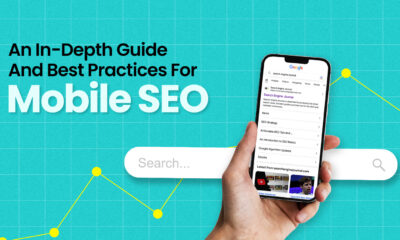
 SEO6 days ago
SEO6 days agoAn In-Depth Guide And Best Practices For Mobile SEO
-

 PPC6 days ago
PPC6 days ago97 Marvelous May Content Ideas for Blog Posts, Videos, & More
-
SEARCHENGINES5 days ago
Daily Search Forum Recap: April 18, 2024
-

 MARKETING5 days ago
MARKETING5 days agoEcommerce evolution: Blurring the lines between B2B and B2C
-
SEARCHENGINES4 days ago
Daily Search Forum Recap: April 19, 2024


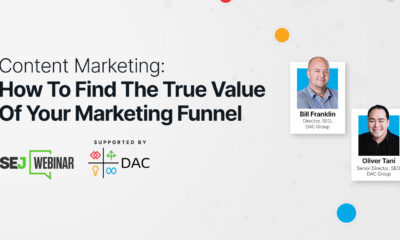



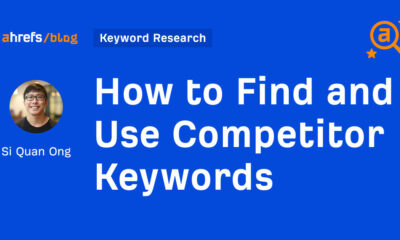









You must be logged in to post a comment Login